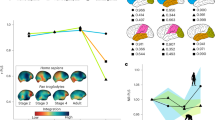Abstract
Directional effect of natural selection on the arrangement of brain of anthropoids and man is reviewed. It is demonstrated that the evolution of the human nervous system is an integrated result of several multidirectional processes. At the early stages of the evolution of primates, the general biological principles of survival of the fittest, i.e., natural selection of the most adapted variants of the brain structure prevailed. During the period of hominid specialization, natural selection led to the formation of the neocortical control of voluntary movements, memory, and mental associations. At later stages of human morphological evolution, biological mechanisms of natural selection of the brain arrangement were replaced by social mechanisms. This process initiated hominid migrations and the growth of the brain size and individual variability in human ancestors. A model of cerebral sorting is proposed to explain the mechanisms of multidirectional selection leading to an increase in brain size of early hominids.
Similar content being viewed by others
References
J. M. Allman, “Evolution of Neocortex,” in: Cerebral Cortex, Ed. by E. G. Jones and A. Peters (Plenum Press, New York, 1990), Vol. 8A, pp. 269–283.
K. Brodmann, Vergleichende Localisationslehre der Grosshirnrinde (Johann Amdrosius Barth, Leipzig, 1925).
A. P. Buzhilova, Homo sapiens: Patient’s Card (Moscow, Yazyki Slavyan. Kul’t., 2005) [in Russian].
A. W. Campbell, Histological Studies on the Localization of Cerebral Function (Cambridge, 1905).
A. Dohrn, Der ursprung der Wirbeltiere und das Prinzip des Functionswechsel (Vogel, Leipzig, 1875).
L. Dollo, “Les lois de l’evolution,” Bull. Soc. Belg. Geol. Bruxelles 7, 164–166 (1893).
I. N. Filimonoff, “Uber die Variabiliant der Grosshirnrindenstruktur. Mit. I. Allgemeine Betrachtungen,” J. Psychol. Neurol. 42(3–4), 210–230 (1931).
I. N. Filimonoff, “Uber die Variabiliant der Grosshirnrindenstruktur. Mit. II. Regio Occipitalis beim erwachsenen,” J. Psychol. Neurol. 44(1–2), 1–96 (1932).
I. N. Filimonoff, “Uber die Variabiliant der Grosshirnrindenstruktur. Mit. III. Regio occipitalis bei hoheren und niederen Affen,” J. Psychol. Neurol. 45(2–3), 69–137 (1933).
S. I. Franz, “New Phrenology,” Science 35, 321–328 (1912).
S. I. Franz and K. S. Lashley, “The Retention of Habits by the Rat after Destruction of the Frontal Portion of the Cerebrum,” Psychobiology 1, 3–18 (1917).
R. L. Holloway, “The Failure of the Gyrification Index (GI) to Account for Volumetric Reorganization in the Evolution of the Human Brain,” J. Hum. Evol. 22, 163–170 (1992).
R. L. Holloway and M. C. DeLaCoste-Larymondie, “Brain Endocast Asymmetry in Pongids and Hominids: Some Preliminary Findings on the Paleontology of Cerebral Dominance,” Am. J. Phys. Anthropol. 58, 101–110 (1982).
R. L. Holloway, D. C. Broadfield, and M. S. Yuan, “Morphology and Histology of the Chimpanse Primary Visual Striate Cortex Indicate that Brain Organisation Predated Brain Expansion in Early Hominid Evolution,” Anat. Rec. 22, 249–257 (2003).
R. L. Holloway, D. C. Broadfield, and M. S. Yuan, Brain Endocast-the Paleoneurological Evidence (John Wiley and, Inc., Hoboken-New Jersey, 2004).
N. Kleinenberg, “Die Entstehung des Annelids aus der Larvae von Lopadorhynchus,” Zschr. F. Wiss. Zool. 44, 1–227 (1886).
K. S. Lashley, Brain Mechanisms and Intelligense (Univ. Chicago Press, Chicago, 1929).
K. S. Lashley and G. Clark, “The Cytoarchitecture of the Cerebral Cortex of Ateles: A Critical Examination with Architectonic Studies,” J. Compar. Neurol. 85, 223–305 (1946).
S. V. Saveliev, Stereoscopic Atlas of Human Brain (Area-17, Moscow, 1996) [in Russian].
S. V. Saveliev, Atlas of Human Brain (VEDI, Moscow, 2005a) [in Russian].
S. V. Saveliev, The Origin of Brain (VEDI, Moscow, 2005b) [in Russian].
S. V. Saveliev, “Neurobiological Approaches in Vertebrate Paleontology,” Paleontol. Zh., No. 6, 3–10 (2008) [Paleontol. J. 42(6), 573–580 (2008)].
S. V. Saveliev, “Principle of Integrity in the Evolution of Associative Centers of the Brain of Vertebrates,” Izv. Ross. Akad. Nauk, Ser. Biol., No. 2, 1–10 (2010).
Yu. G. Shevchenko “Lower Parietal Region in Apes,” Tr. Inst. Mozga TsIK SSSR, No. 2, 155–202 (1936).
Yu. G. Shevchenko Evolution of Brain Cortex in Primates and Man (Mosk. Gos. Univ., Moscow, 1971) [in Russian].
I. A. Stankevich and Yu. G. Shevchenko, “Structural Variability of the Cerebral Cortex of Brain: Lower Parietal Region in Adult Man,” Tr. Inst. Mozga TsIK SSSR, No. 1, 119–174 (1935).
Author information
Authors and Affiliations
Corresponding author
Rights and permissions
About this article
Cite this article
Saveliev, S.V. Natural selection in brain evolution of early hominids. Paleontol. J. 44, 1589–1597 (2010). https://doi.org/10.1134/S0031030110120130
Received:
Published:
Issue Date:
DOI: https://doi.org/10.1134/S0031030110120130




